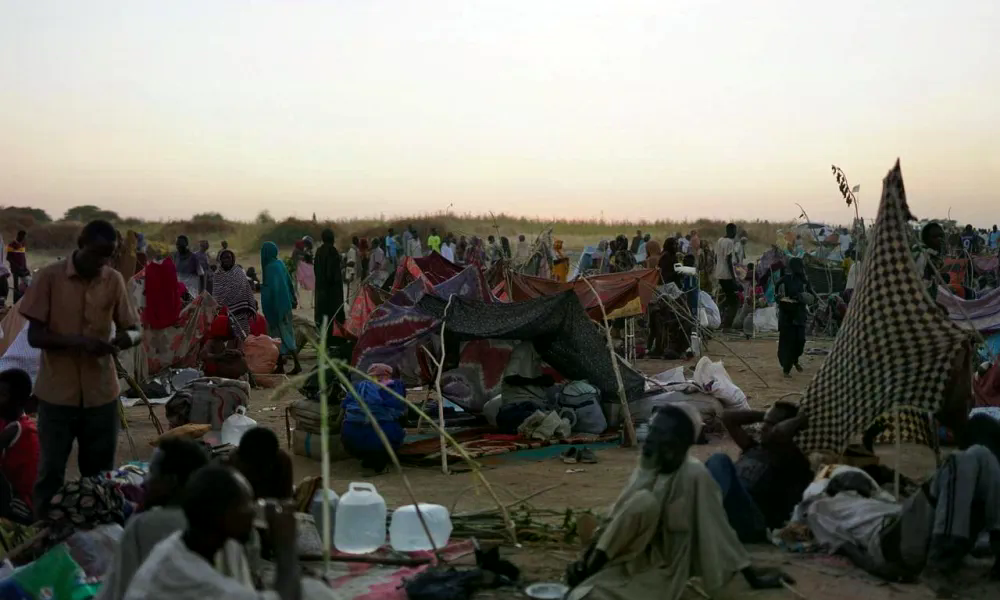
People who have fled the western city of El-Fasher in war-torn Sudan are describing scenes of extreme violence committed by the paramilitary Rapid Support Forces (RSF). Aid workers warn that only a small portion of the city’s population has managed to escape, as the conflict continues to escalate.
According to the Sudan Doctors Network, the RSF has killed at least 1,500 people in El-Fasher, the capital of North Darfur state, since seizing the city on Sunday. This includes at least 460 individuals in a hospital during a widely condemned massacre. Over 36,000 residents have fled the area since Saturday, mostly on foot, heading toward Tawila, a town approximately 70 kilometers (43 miles) west, which is already home to around 650,000 displaced people.
Hayat, a mother of five children, described to AFP via satellite phone how seven RSF fighters entered her home, searched her undergarments, and killed her 16-year-old son in front of her. She recalled seeing many dead bodies and wounded people left behind as she fled with neighbors. “We saw many dead bodies lying on the ground and wounded people left behind in the open because their families couldn’t carry them,” she said.
Another survivor, Hussein, was injured by shelling but managed to reach Tawila with the help of a family carrying their mother on a donkey cart. He described the situation in El-Fasher as “terrible,” noting that “dead bodies are in the streets, and no one to bury them.” He added, “We’re grateful we made it here, even if we only have the clothes we were wearing.”
Aisha Ismael, another displaced person from El-Fasher, told The Associated Press that shelling and drone attacks occurred constantly. She recounted hiding in houses during the day and sneaking out at night, eventually reaching Hillat Alsheth, where she was robbed. “They left us with nothing. I came here barefoot, even my shoes were taken,” she said.
Al Jazeera’s Hiba Morgan reported from Khartoum that thousands continue to flee El-Fasher. She cited the Sudan Doctors Network, which tracks the country’s civil war, as stating that at least 15,000 people arrived in Tawila in the past 48 hours alone. Many of them require urgent medical assistance after walking for days without food or water and suffering injuries.
Mathilde Vu, advocacy manager for the Norwegian Refugee Council, which oversees the Tawila camp, told the Associated Press that the number of people who reached Tawila is “very small.” “Where are the others?” she asked. “That tells the horror of the journey.”
The United Nations humanitarian chief, Tom Fletcher, warned that the “catastrophic levels of human suffering” in El-Fasher have descended into an even darker situation. Speaking to the UN Security Council, which held an emergency meeting on the crisis, Fletcher expressed alarm over reports of mass killings by the RSF. He emphasized that the “horror is continuing … with utter impunity.”
Fletcher also raised concerns about the dire humanitarian conditions in Tawila, noting that the area is already hosting hundreds of thousands of displaced people and is now at breaking point. Those attempting to flee to the southwest face “extortion, rape,” while men have been “abducted or killed on the road,” he said. Attempts to deliver aid have been blocked by the RSF.
In response, the United Nations approved a $20 million allocation from the Central Emergency Response Fund to support relief efforts in Tawila and other parts of Darfur. UN Secretary-General spokesperson Stephane Dujarric stated that the organization was “horrified” by the slaughter of more than 450 people at Saudi Hospital, where patients, health workers, and residents had sought shelter. He noted that elderly individuals, the wounded, and those with disabilities remain “stranded and unable to flee the area.”
Shayna Lewis, a Sudan specialist, told Al Jazeera that the massacre of civilians was “most devastating” due to long-standing warnings from civil society about the risks to North Darfur’s civilian population. For 18 months before the Sudanese army withdrew from the city, an RSF siege trapped hundreds of thousands of people without food or essential supplies.
Lewis highlighted that the scale of the violence was “astonishing,” citing satellite imagery from Yale’s Humanitarian Research Lab (HRL) showing clusters of objects consistent with human bodies and large areas of red discoloration on the ground. These images provide visible evidence of the widespread bloodshed.


